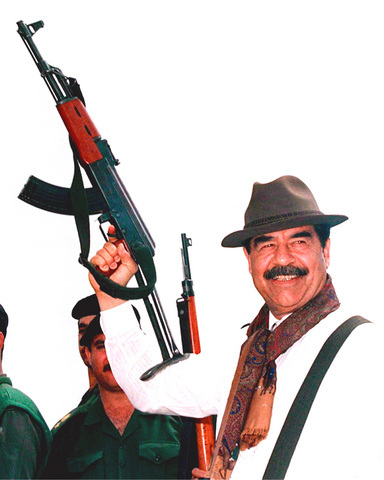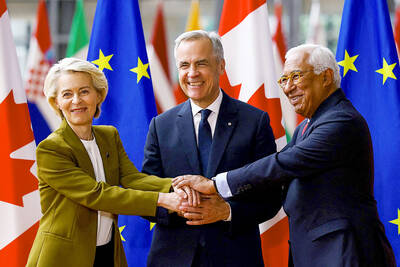The hanging of Saddam Hussein ended the life of one of the most brutal tyrants in recent history and negated the fiction that he himself maintained even as the gallows loomed -- that he remained president of Iraq despite being toppled by the US military and that his power and his palaces would be restored to him in time.
He was 69.
The despot, known as Saddam, had oppressed Iraq for more than 30 years, unleashing devastating regional wars and reducing his once promising, oil-rich nation to a claustrophobic police state.

PHOTO: EPA/INA
For decades it seemed that his unflinching hold on Iraq would endure, particularly after he lasted through disastrous military adventures against first Iran and then Kuwait, where a US-led coalition routed his unexpectedly timid military in 1991.
His own conviction that he was destined by God to rule Iraq forever was such that he refused to accept that he would be overthrown in April 2003, even as US tanks penetrated the Iraqi capital of Baghdad in what became a bitterly contentious, bloody occupation.
Manhunt
Saddam eluded capture for eight months during an intensive manhunt, maintained until the end that he was Iraq's rightful president. "High Value Detainee No. 1," his US military code name, heaped scorn on the Iraqi judge who referred to him as the "former" president after asking him to identify himself on the first day of his trial for crimes against humanity, which ultimately lead to his execution.
"I didn't say `former president,' I said `president,' and I have rights according to the Constitution, among them immunity from prosecution," Saddam growled from the docket.
The outburst underscored the boundless egotism and self-delusion of a man who fostered such a fierce personality cult during the decades that he ran the Middle Eastern nation that joking or criticizing him in public could bring a death sentence.
If a man's life can be boiled down to one physical mark, in Saddam's case it was the wrist of his right hand, which was tattooed with a line of three dark blue dots, a mark commonly given to children in rural, tribal areas. Some urbanized Iraqis removed or at least bleached theirs, but Saddam's former confidantes told the Atlantic Monthly that he never disguised his.
Peasant
Ultimately, underneath all the socialist rhetoric, underneath the Koranic references, the tailored suits and the invocations of Iraq's glorious history, Saddam was basically a village peasant attempting to be a tribal leader on a grand scale. His rule was paramount, and sustaining it was his main goal behind all the talk of developing Iraq by harnessing its considerable wealth and manpower.
Mosques, airports, neighborhoods and entire cities were named after him.
While Saddam was in power, his statue guarded the entrance to every village, his portrait watched over each government office and he peered down from at least one wall in every home. His picture was so widespread that a joke quietly circulating among his detractors in 1988 put the country's population at 34 million -- 17 million people and 17 million portraits of Saddam.
Throughout his rule Saddam unsettled the ranks of the Baath Party with bloody purges and packed his jails with political prisoners to defuse real or imagined plots. In one of his most brutal acts, he rained poison gas on the northern Kurdish village of Halabja in 1988, killing an estimated 5,000 of his own citizens suspected of being disloyal and wounding some 10,000 more.
Even at the end, Saddam showed no remorse. When four members of the temporary government that replaced him visited him after his capture in December 2003, they asked about some of his more brutal acts. Saddam responded that the Halabja attack had been Iran's handiwork, that Kuwait was rightfully part of Iraq and that the mass graves were filled with thieves who fled the battlefields, according to Adnan Pachachi, a former Iraqi foreign minister. Saddam declared that he'd been "just but firm" because Iraqis needed a tough ruler, Pachachi said.
Aside from his secret police, the main factor that preserved his power was his practice of filling the regime's upper ranks with members of his extended clan, regardless of their qualifications.
Saddam Hussein was born on April 28, 1937, in a mud hut on stilts near the banks of the Tigris River near the village of Tikrit, 160km northwest of Baghdad. He was raised by a clan of landless peasants, his father apparently having deserted his mother before his birth -- Government accounts said the father died.
"His birth was not a joyful occasion, and no roses or aromatic plants bedecked his cradle," his official biographer, Amir Iskander, wrote in Saddam Hussein, the Fighter, the Thinker and The Man, published in 1981.
Saddam's wife, three daughters and roughly a dozen grandchildren survive him. His sons Uday and Qusay, along with Qusay's teenage son, Mustapha, died in July 2003 during a fierce gunbattle with US forces in a villa in the northern city of Mosul. Denounced by an informant, they had been the two most wanted men in Iraq after their father.
Savage
No other Arab despot matched the savagery of Saddam as he went about bending all state institutions to his whim. His notorious opening act, in January 1969, was hanging about 17 so-called spies for Israel, up to 13 of them Jews, in a downtown Baghdad square. Hundreds of arrests and executions followed as the civilian wing of Baath gradually eclipsed the Iraqi military.
Rarely traveling abroad, surrounded by often uneducated cousins, Saddam had a rather limited world view. He once reacted with wonder when a reporter told him that the US had no law against insulting the president. Former officials painted him as a vain, paranoid loner who no longer believed he was a normal person and considered compromise a sign of weakness.
There were widespread reports that Saddam himself periodically carried out the torture or even execution of those he felt had crossed him.
Saddam often tried to draw parallels between himself and the famous leaders of Mesopotamia, the earliest civilization in the region, as well as Saladin, the 12th century Kurdish Muslim military commander who expelled the Crusaders from Jerusalem.
What preoccupied him, Saddam said, was what people would be thinking about him 500 years from now. To the horror of historic preservationists, he had the ancient walls of Babylon completely reconstructed using tens of thousands of newly fired bricks. An archaeologist had shown him bricks stamped with the name of Nebuchadnezzar II in 605 BC.
After the reconstruction, the small Arabic script on thousands of bricks read: "In the reign of the victorious Saddam Hussein, the president of the Republic, may God keep him, the guardian of the great Iraq and the renovator of its renaissance and the builder of its great civilization, the rebuilding of the great city of Babylon was done."

Drug lord Jose Adolfo Macias Villamar, alias “Fito,” was Ecuador’s most-wanted fugitive before his arrest on Wednesday, more than a year after he escaped prison from where he commanded the country’s leading criminal gang. The former taxi driver turned crime boss became the prime target of law enforcement early last year after escaping from a prison in the southwestern port of Guayaquil. Ecuadoran President Daniel Noboa’s government released “wanted” posters with images of his face and offered US$1 million for information leading to his capture. In a country plagued by crime, members of Fito’s gang, Los Choneros, have responded with violence, using car

Canada and the EU on Monday signed a defense and security pact as the transatlantic partners seek to better confront Russia, with worries over Washington’s reliability under US President Donald Trump. The deal was announced after a summit in Brussels between Canadian Prime Minister Mark Carney and European Commission President Ursula von der Leyen and European Council President Antonio Costa. “While NATO remains the cornerstone of our collective defense, this partnership will allow us to strengthen our preparedness ... to invest more and to invest smarter,” Costa told a news conference. “It opens new opportunities for companies on both sides of the

The team behind the long-awaited Vera Rubin Observatory in Chile yesterday published their first images, revealing breathtaking views of star-forming regions as well as distant galaxies. More than two decades in the making, the giant US-funded telescope sits perched at the summit of Cerro Pachon in central Chile, where dark skies and dry air provide ideal conditions for observing the cosmos. One of the debut images is a composite of 678 exposures taken over just seven hours, capturing the Trifid Nebula and the Lagoon Nebula — both several thousand light-years from Earth — glowing in vivid pinks against orange-red backdrops. The new image

OVERHAUL: The move would likely mark the end to Voice of America, which was founded in 1942 to counter Nazi propaganda and operated in nearly 50 languages The parent agency of Voice of America (VOA) on Friday said it had issued termination notices to more than 639 more staff, completing an 85 percent decrease in personnel since March and effectively spelling the end of a broadcasting network founded to counter Nazi propaganda. US Agency for Global Media (USAGM) senior advisor Kari Lake said the staff reduction meant 1,400 positions had been eliminated as part of US President Donald Trump’s agenda to cut staffing at the agency to a statutory minimum. “Reduction in Force Termination Notices were sent to 639 employees at USAGM and Voice of America, part of a